Aswan Dam
| Aswan High Dam | |
|---|---|
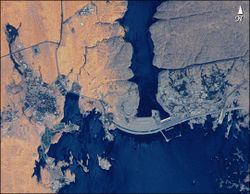 The Aswan High Dam as seen from space |
|
| Official name | Aswan High Dam |
| Locale | |
| Coordinates | |
| Opening date | 1970 |
| Dam and spillways | |
| Length | 3,830 m (12,566 ft) |
| Height | 111 m (364 ft) |
| Base width | 980 m (3,215 ft) |
| Impounds | River Nile |
| Spillway capacity | 11,000 m3/s (390,000 cu ft/s) |
| Reservoir | |
| Creates | Lake Nasser |
| Capacity | 111 km3 (27 cu mi) |
| Surface area | 5,250 km2 (2,027 sq mi) |
| Power station | |
| Turbines | 12 |
| Installed capacity | 2,100 MW |
The Aswan Dam is the general name for two dams, both of which are situated across the Nile River in Aswan, Egypt. Since the 1950s, the name commonly refers to the High Dam, which is the larger and newer of the two. The Old Aswan Dam, or Aswan Low Dam, was first completed in 1902 and raised twice, during the British colonial period. Following independence, the High Dam was constructed between 1960 and 1970. Both projects aimed to increase economic production by regulating the annual river flooding and providing storage of water for agriculture, and later, to generate hydroelectricity. Both have had immense impacts on the economy and culture of Egypt. The Old Aswan Dam was built at the former first cataract of the Nile, and is located about 1,000 kilometres (620 mi) (686 kilometres (426 mi)) up-river and south-southeast of Cairo. The newer Aswan High Dam is located a further 7.3 kilometres (4.5 mi) upriver from the older dam.
Before the dams were built, the River Nile flooded each year during summer, as water flowed down the valley from its East African drainage basin. These floods brought high water and natural nutrients and minerals that annually enriched the fertile soil along the floodplain and delta; this made the Nile valley ideal for farming since ancient times. Because floods vary, in high-water years, the whole crop might be wiped out, while in low-water years widespread drought and famine occasionally occurred. As Egypt's population grew and conditions changed, both a desire and ability developed to control the floods, and thus both protect and support farmland and the economically important cotton crop. With the reservoir storage provided by these dams, the floods could be lessened, and the water could be stored for later release.
Contents |
Construction history
The earliest attempt of building a dam in Aswan dates back to the 11th century, when the Iraqi polymath and engineer Ibn al-Haytham (known as Alhazen in the West) was summoned to Egypt by the Fatimid Caliph, Al-Hakim bi-Amr Allah, to regulate the flooding of the Nile, a task requiring an early attempt at an Aswan Dam.[1] After his field work made him aware of the impracticality of this scheme,[2] and fearing the caliph's anger, he feigned madness. He was kept under house arrest from 1011 until al-Hakim's death in 1021, during which time he wrote his influential Book of Optics.
Aswan Low Dam
Following their 1882 invasion and occupation of Egypt, the British began construction of the first dam across the Nile in 1898. Construction lasted until 1902, and it was opened on 10 December 1902, by HRH the Duke of Connaught and Strathearn. The project was designed by Sir William Willcocks and involved several eminent engineers of the time, including Sir Benjamin Baker and Sir John Aird, whose firm, John Aird & Co., was the main contractor.[3][4]
The Old Aswan Dam was designed as a gravity-buttress dam; the buttress sections accommodate numerous gates, which were opened yearly to pass the flood and its nutrient-rich sediments, but without retaining any yearly storage. The dam was constructed of rubble masonry and faced with red ashlar granite. When constructed, the Old Aswan Dam was the largest masonry dam in the world.[5] The design also included a navigation lock of similar construction on the western bank, which allowed shipping to pass upstream as far as the second cataract, before a portage overland was required. At the time of its construction, nothing of such scale had ever been attempted.[6] Despite initial limitations imposed on its height, due to concern for Philae Temple, the initial construction was soon found to be inadequate for development needs, and the height of the dam was raised in two phases, 1907–1912 and 1929–1933, and generation of electricity was added. With its final raising, the dam is 1,950 m in length, with a crest level 36 m above the original river bed;[5] the dam provides the main route for traffic between the city and the airport. With the construction of the High Dam upstream, the Old Dam's ability to pass the flood's sediments was lost, as was the serviceability provided by the locks. The previous Old Dam reservoir level was also lowered and now provides control of tailwater for the High Dam.
Aswan High Dam Politics and Funding
After the Low Dam was almost over-topped in 1946, the British administration decided that rather than raise the dam a third time, a second dam should be built 6 km upriver (about 4 miles). The post-war years saw major changes in Egypt, including the growth of nationalism, the abrogation of earlier treaties with colonial Britain, and the overthrow of the monarchy, led by the Free Officers Movement, and its ultimate leader, Gamal Abdel Nasser.
Planning for the "High Dam" proper began in 1954, following the revolution, and changed development priorities. Initially, both the USA and USSR were interested in the development of the dam, but this occurred in the increasingly tense readings of Cold War happenings, as well as growing intra-Arab rivalries.
In 1955, Nasser was trying to portray himself as the leader of Arab nationalism, in opposition to the traditional monarchies, especially Hashemite Iraq following its signing of the Baghdad Pact that year. At this time the US was concerned with the possibility of communism spreading to the Middle East, and saw Nasser as a natural leader of an anti-communist Arab league. The US and Britain offered to help finance construction of the high dam with a loan of US$270 million in return for Nasser's leadership in resolving the Arab-Israeli conflict. While opposed both to communism and imperialism, Nasser presented himself as a tactical neutralist, and sought to work with both the US and USSR for Egyptian and Arab benefit.[7]
After a particularly criticized raid by Israel against Egyptian forces in Gaza in 1955, Nasser realised that he could not legitimately portray himself as the leader of pan-Arab nationalism if he could not defend the country militarily against Israel. In addition to his development plans, he looked to quickly modernise his military, and turned first to the US.
US Secretary of State John Foster Dulles and US President Dwight Eisenhower told Nasser that the US would supply him with weapons only if they were used for defensive purposes and accompanied by US military personnel for supervision and training. Nasser did not accept these conditions and then looked to the Soviet Union for support. Although Dulles believed that Nasser was only bluffing, and that the USSR would not aid Nasser, he was wrong; the USSR promised Nasser a quantity of arms in exchange for a deferred payment of Egyptian grain and cotton. On September 27, 1955, Nasser announced an arms deal, with Czechoslovakia acting as a middleman for the Soviet support.[8] Instead of retaliating against Nasser for turning to the Soviets, Dulles sought to improve relations with him. This explains the later offer of December 1955, in which the US and UK pledged $56 and $14 million respectively towards the construction of the dam.[9].
Though the "Czech arms deal" actually increased US willingness to invest in Aswan, the British cited the deal as a reason for withdrawing their funding. What angered Dulles much more was Nasser’s recognition of communist China, which was in direct conflict with Dulles's policy of containment.[10] There are several other reasons why the US decided to withdraw the offer of funding. Dulles believed that the Soviet Union would not actually make good on its promise to help the Egyptians. He was also irritated by Nasser’s neutrality and attempts to play both sides of the Cold War. At the time, other western allies in the Middle East, like Turkey and Iraq, were irritated that a persistently neutral country like Egypt was being offered so much aid.[11]
In June 1956, the Soviets offered Nasser $1,120,000,000 at 2% interest for the construction of the dam. The next month, on July 19, the United States State Department announced that it deemed American financial assistance for the High Dam "not feasible in present circumstances."[9]
On July 26, 1956, with wide Egyptian acclaim, Nasser announced the nationalization of the Suez Canal as well as fair compensation for the former owners. Ostensibly, the revenues generated by the canal would help fund High Dam construction. The Suez War broke out, The United Kingdom, France, and Israel tried to invade Egypt, but, in the same year 1956, they failed and had to withdraw from the small positions which they had seized for a short time.
In 1958, the Soviet Union stepped in and funded the dam project.
In the late 1950s the reservoir raised concern with archaeologists because major historical sites were about to be under water. A rescue operation began in 1960 under UNESCO, see below.
Construction and Filling 1960-1976
The Soviets also provided technicians and heavy machinery. The enormous rock and clay dam was designed by the Soviet Hydroproject Institute along with some Egyptian engineers. 25 thousand Egyptian engineers and workers formed the backbone of the workforce required to complete this tremendous project which deeply changed many aspects in Egypt.
On the Egyptian side, the project was led by Osman Ahmed Osman's Arab Contractors. The relatively young Osman underbid his only competitor by one-half [12].
1960: Start of construction.
1964: First dam construction stage completed, reservoir started filling.
21 July 1970: The High Dam, as-Sad al-'Aali, an embankment dam, was completed after 10 years.
1976: Reservoir reached capacity.
Specifications
The Aswan High Dam is 3,830 metres long, 980 metres wide at the base, 40 metres wide at the crest and 111 metres tall. It contains 43 million cubic metres of material. At maximum, 11,000 cubic metres of water can pass through the dam every second. There are further emergency spillways for an extra 5000 cubic metres per second and the Toshka Canal links the reservoir to the Toshka Depression. The reservoir, named Lake Nasser, is 550 km long and 35 km at its widest with a surface area of 5,250 square kilometres. It holds 111 cubic kilometres of water.

Benefits
Periodic floods and droughts, known since Biblical times (Genesis 41:35-36), caused devastating effect on the population in the Nile Delta. The dam mitigated the effects of these dangerous floods, such as in 1964 and 1973, and the effects the droughts in 1972-1973 and the drought of 1983-1984 that devastated East Africa and Somalia. Also, a new fishing industry has been created around Lake Nasser, though it is struggling due to its distance from any significant markets.
The High Dam increased the farmland 500% since 1970.
The dam powers twelve generators each rated at 175 megawatts, producing a hydroelectric output of 2.1 gigawatts. Power generation began in 1967. When the dam first reached peak output it produced around half of Egypt's entire electricity production (about 15% by 1998) and allowed most Egyptian villages to use electricity for the first time.
Environmental and cultural problems
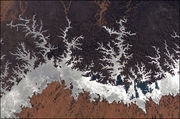
Damming the Nile has caused a number of environmental and cultural problems.
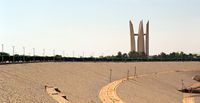
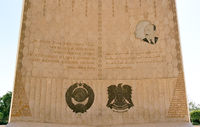
Displacement, agriculture and health
It flooded much of lower Nubia and over 60,000 people were displaced.[13]
The valuable silt which the Nile deposited ashore in the yearly floods and made the Nile floodplain fertile is now held behind the dam. Silt deposited in the reservoir is lowering the water storage capacity of Lake Nasser. Poor irrigation practices beyond the dam are water logging soils and bringing salt to the surface. Mediterranean fishing declined after the dam was finished because nutrients that used to flow down the Nile to the Mediterranean were trapped behind the dam.
There is some erosion of farmland down-river as the river used to replenish its sediment during floods, but now most sediment stays behind the walls of the dam. Erosion of coastline barriers due to lack of new sediments from floods will eventually cause loss of the brackish water lake fishery that is currently the largest source of fish for Egypt, and the breakdown of the Nile Delta may lead to inundation of the northern portion of the delta with seawater, in areas which are now used for rice crops. The delta itself, no longer renewed by Nile silt, has lost much of its fertility. The red-brick construction industry, which used delta mud, is also severely affected. There is significant erosion of coastlines (due to lack of sand, which was once brought by the Nile) all along the eastern Mediterranean.
As evaporating water in these areas extracts minerals out of the ground, a layer of salt crystals on the soil is often created, causing salinization and decreased yield.
Furthermore, the standing water is a breeding ground for snails carrying the parasite bilharzia, in Egypt the second worst parasite after malaria.[14]
The increased use of artificial fertilizers in farmland below the dam has caused chemical pollution which the traditional river silt did not do. Lack of irrigation control has also caused some farmland to be damaged by water logging and increased salinity, a problem complicated by the reduced flow of the river, which allows salt water to encroach further into the delta.
The Aswan Dam tends to increase the salinity of the Mediterranean Sea, and this affects the Mediterranean's outflow current into the Atlantic Ocean (see Strait of Gibraltar). This current can be traced thousands of kilometers into the Atlantic.
Due to the Aswan Dam inhibiting the natural fluctuations in water height, i.e. floods, the bilharzia disease has flourished causing great expense to the Egyptian economy and people.
Archeological Monuments Flooding and UNESCO Rescue Campaign
In the late 1950s, the reservoir raised concern with archaeologists because major historical sites were about to be under water. A rescue operation began, in 1960, under UNESCO. Sites were to be surveyed and excavated.
The Great Temple of Abu Simbel was preserved by relocating 22 monuments and architectural complexes to the shores of Lake Nasser under the UNESCO Nubia Campaign.[15]. Other monuments were granted to countries that helped with the works (such as the Debod temple in Madrid, the Temple of Taffeh in Leiden and the Temple of Dendur in New York). The remaining archeological sites have been flooded by Lake Nasser, among others the Buhen fort.
Irrigation for agriculture
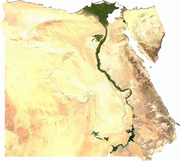
Due to the absence of appreciable rainfall, Egypt's agriculture depends entirely on irrigation. With irrigation, two crops per year can be produced, except for sugar cane which has a growing period of almost one year.
The high dam at Aswan releases, on average, 55 billion m³ water per year of which some 46 billion m³ are diverted into the irrigation canals.
In the Nile valley and delta, almost 8 million feddan (1 feddan is 1.038 acre or 4200.835 m2) benefit from these waters producing on average 1.8 crops per year. The annual crop consumptive use of water is about 38 billion m³. Hence, the overall irrigation efficiency is 38/46 = 0.82 or 82%. This is a relatively high irrigation efficiency. The field irrigation efficiencies are much less, but the losses are re-used downstream. This continuous re-use accounts for the high overall efficiency.
The following table shows that the equal distribution of irrigation water over the branch canals taking off from the main irrigation canals leaves much to be desired [16] :
| Branch canal | Water delivery in m³/feddan *) |
|---|---|
| Kafret Nasser | 4700 |
| Beni Magdul | 3500 |
| El Mansuria | 3300 |
| El Hammami upstream | 2800 |
| El Hammami downstream | 1800 |
| El Shimi | 1200 |
*) Period 1 March to 31 July. 1 feddan is about 1 acre or 0.42 ha.
*) Data from the Egyptian Water Use Management Project (EWUP) [17]
Salt balance
The salt concentration of the water in the Aswan reservoir is about 0.25 kg/m³. This is very non-salty. At an annual inflow of 55 billion m³, the annual salt import reaches 14 million tons. The average salt concentration of the drainage water evacuated into the sea and the coastal lakes is 2.7 kg/m³ [18] . At an annual discharge of 10 billion m³ (not counting the 2 billion m³ of salt intrusion from the sea and the lakes, see figure "Water balances"), the annual salt export reaches 27 million ton. In 1995, the salt export was higher than the import, and Egypt's agricultural lands were desalinizing. Part of this could be due to the large number of subsurface drainage projects executed in the last decades to control the water table and soil salinity.[19]
Drainage
Drainage through sub-surface drains and drainage channels is essential to prevent a deterioration of crop yields from waterlogging and soil salinization caused by irrigation. By 2003 more than 2 million ha have been equipped with a subsurface drainage system and approximately 7.2 billion m3 of water is drained annually from areas with these systems. The total investment cost in agricultural drainage over 27 years from 1973 to 2002 was about 3.1 billion US$ covering the cost of design, construction, maintenance, research and training. During this period 11 large scale projects were implemented with financial support from World Bank and other donors [20]
- See also: Water resources management in Egypt
See also
- List of conventional hydroelectric power stations
- List of largest dams
- List of power stations in Egypt
- Water supply and sanitation in Egypt
- Water politics in the Nile Basin
- Egyptian Public Works
References
- ↑ Rashed, Roshdi (2002-08-02), "PORTRAITS OF SCIENCE: A Polymath in the 10th Century", Science (Science magazine) 297 (5582): 773, doi:10.1126/science.1074591, PMID 12161634, http://www.sciencemag.org/cgi/content/full/297/5582/773, retrieved 2008-09-16
- ↑ Corbin, Henry (1993; original French 1964), History of Islamic Philosophy, Translated by Liadain Sherrard, Philip Sherrard, London; Kegan Paul International in association with Islamic Publications for The Institute of Ismaili Studies, p. 149, ISBN 0710304161
- ↑ Egypt bond
- ↑ Roberts, Chalmers (December 1902), "Subduing the Nile", The World's Work: A History of Our Time V: 2861–2870
- ↑ 5.0 5.1 V. Novokshshenov, Laboratory studies of the stone masonry in the Old Aswan Dam, Materials and Structures 1993, Vol. 26, p. 103-110
- ↑ Frederic Courtland Penfield, Harnessing the Nile, Century Magazine, Vol. 57, No. 4 (February, 1899)
- ↑ The Aswan Decision in Perspective Author(s): James E. Dougherty Source: Political Science Quarterly, Vol. 74, No. 1 (Mar., 1959), pp. 21-45 Published by: The Academy of Political Science
- ↑ Smith, Page 242
- ↑ 9.0 9.1 Dougherty, Page 22
- ↑ Smith, 247
- ↑ Smith, Charles D. Palestine and the Arab-Israeli Conflict (Sixth Edition). Boston/New York: Bedford/St. Martin’s. 2007.
- ↑ Osman the Efficient
- ↑ A comparative survey of dam-induced resettlement in 50 cases by Thayer Scudder and John Gray [1]
- ↑ William R. Jobin, 1999. Dams and Disease: Ecological Design and Health Impacts of Large Dams, Canals, and Irrigation Systems, Taylor & Francis, ISBN 0-419-22360-6 [2]
- ↑ The Rescue of Nubian Monuments and Sites, UNESCO project site about Nubia Campaign.
- ↑ Impacts of the Irrigation Improvement Projects in Egypt. Egyptian-Dutch Advisory Panel and International Institute for Land Reclamation and Improvement, Wageningen, The Netherlands, 1999. Download from : [3] , under nr. 4, or directly as PDF : [4]
- ↑ Egyptian Water Use Management Project (EWUP), 1984. Improving Egypt’s Irrigation System in the Old Lands, Final Report. Colorado State University and Ministry of Public Works and Water Resources
- ↑ Egyptian Drainage Research Institute, DRI, yearbook 1995/1996
- ↑ M.S.Abdel-Dayem, 1987. Development of land drainage in Egypt. In: J.Vos (Ed.) Proceedings, Symposium 25th International Course on Land Drainage. ILRI publ. 42. International Institute for Land Reclamation and Improvement, Wageningen, The Netherlands.
- ↑ Ministry of Water Resources and Irrigation, Egyptian Public Authority for Drainage Projects, Drainage Research Institute, 2006: The National Drainage and Drainage Water Reuse Programs, Egypt, Local Actions at the 4th World Water Forum, March 2, 2007, accessed on April 28, 2010